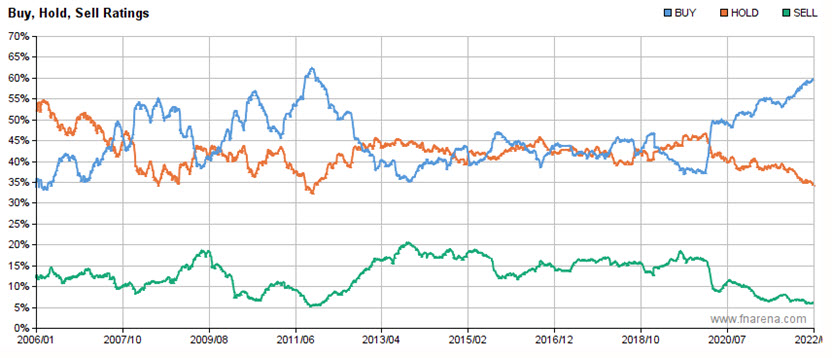Broker "Buy" ratings signal bear market
2022 is not your garden variety share market, but the weirdest anomaly surely must be in stockbrokers' recommendations for individual ASX-listed companies.
As of the end of April, and with the ASX200 still within reach of its all-time high, total recommendations for the seven stockbrokers monitored daily by FNArena on 437 individual stocks comprise of 60% Buys (and equivalents) versus less than 35% in Hold/Neutral ratings and Sell ratings close to 5%.
What makes this set-up so unusual is that, historically, such a large percentage in Buy ratings, and respective low percentages for Hold and Sell recommendations, points to bear market conditions for the local share market.
The numbers are well out-of-whack with long term averages since FNArena started compiling these data back in 2006. The only precedent over the past 16 years occurred in 2011 when financial markets were gripped by anxiety that debt-laden Greece might turn into the bombshell that would cause the implosion of the European Union.

That scenario ultimately did not happen, but until that confidence-fueling declaration made by ECB president Mario Draghi in July 2012, financial markets could not shake off the threat of a worst case outcome. Thus share markets didn't go anywhere. Stockbrokers in Australia responded by issuing ever more Buy ratings, which at that time peaked above 60% of all recommendations. Sell ratings, similar to today, bottomed at 5% - the lowest percentage recorded throughout the 16 year period.
Note that during the GFC, the total percentage of Buy ratings peaked closer to 55%, as occurred again post-GFC in 2010. Both in 2008 as again in 2010-2011 such extreme readings in broker recommendations ultimately provided a positive signal for favourable entry-points for investors, though in both cases a healthy dose of patience was still required.
If we assume today's signal will equally prove as positive as back in 2011 and 2008, how then can we explain the key difference in price action? Back in 2008 shares were going through the worst bear market in living memory and in 2011 investors had to bide their time until the ECB president inspired a strong rally that quickly closed the gap between moribund share prices and intrinsic valuations.
If we are in a bear market in 2022, the typical pattern thus far in Australia is predominantly showing up through extreme volatility. The past four months have seen a number of sharp sell-offs, but equally of sharp recovery rallies. Year-to-date, and after a mildly negative April performance, the ASX200 is close to unchanged for the calendar year thus far. Over the past twelve months its performance stands at a positive 8.40%.
But the ASX has been outperforming most of its peers globally. Global equities, as per the S&P Global BMI proxy, are now down -11.55% calendar-year-to-date and compared with twelve months ago the performance is a negative -5.37%. The S&P500 in the US is down -9.65% since the start of 2022, and holding on to a narrow 3.94% gain left for the twelve months past. The tech-laden Nasdaq has lost more than -21% to date in 2022.
Underneath the resilience shown by the ASX200, there are plenty of negative experiences to report upon. Former BNPL runner up in Australia, Zip Co ((Z1P)) is now down -70% in three months and down -86% over the past year. Once popular fintech EML Payments ((EML)) is down -48% in three months and -72% over the past twelve. The once universally held in high esteem, Platinum Asset Management ((PTM)) has lost -60% in value over the year past, and is now at risk of being booted out of the ASX200.
Shares in online retailer Kogan ((KGN)) tanked more than -15% over successive days since its latest market update revealed yet more disappointment. Less than one year ago, Kogan shares changed hands for $13 a piece, today they are trading at around $3.80 for a fall of close to -70%. Top50 member ResMed ((RMD)) has equally failed to meet market expectations and the result, including post-quarterly update disappointment, is for a loss of -30% since September last year.
The experience has been equally disheartening for the likes of Aristocrat Leisure ((ALL)), Life360 ((360)), Tyro Payments ((TYR)), Domino's Pizza ((DMP)), Codan ((CDA)), and many others, while the likes of Whitehaven Coal ((WHC)), Sims Group ((SGM)), Nufarm ((NUF)), GrainCorp ((GNC)), Allkem ((AKE)), Perseus Mining ((PRU)) and Flight Centre ((FLT)) offset with stellar gains.
Maybe it is this extreme polarisation that is fundamentally responsible for why stockbroker ratings are signalling bear market conditions while the index is not reflecting it?
Taking an optimistic view, this would make sense if prices for commodities -both bulk and industrial as well as agricultural- continue to surprise on the upside over the year ahead. Note, for example, recent market updates for the likes of Nufarm and GrainCorp provided upside surprises, while dividend expectations are only growing for miners such as Whitehaven Coal and -even- Allkem.
On the other hand, there's equally an argument to be made that many of the non-cyclicals on the ASX are looking firmly over-sold, similar to what was the general situation back in 2011 and in 2008. Investor appetite for companies such as Aristocrat Leisure, Dominio's Pizza and ResMed is currently close to non-existent, but that doesn't tell us anything about the future outlook or intrinsic valuations.
The statistics concerning broker valuations and price targets compared to where share prices are trading today are showing an even rosier picture than the ratings do. Consider, for example, only 65 of the 437 ASX-listed shares covered by the seven stockbrokers are currently trading above their consensus price target.
If we raise our benchmark to a gap between share price and consensus target of at least -10%, this only removes 150 of the 437 stocks, leaving 287 (circa 66%) that look undervalued-by-a-margin. More than 100 stocks are currently trading -33% or more below their target.
Sure, there will be more than the occasional blooper that turns out very-cheap-for-a-very-good-reason, but I also suspect these numbers are so heavily skewed because underneath the local share market's optical resilience, there has been a lot more pain inflicted and damage done than is widely reported or given credit for.
So what might reinvigorate market sentiment towards share prices for, say, City Chic Collective ((CCX)), James Hardie Industries ((JHX)), Nine Entertainment ((NEC)), NextDC ((NXT)), and Netwealth Group ((NWL))?
A positive result before or in August might be a great starting point as targets and valuations are but a mathematical outcome of what is currently being projected for the year(s) ahead. However, similar to 2011, it remains a genuine possibility that macro threats and considerations will continue to weigh on overall market sentiment.
We've now had the bond market reset and the inflation scare; next up will be global growth slowing plus the unknown consequences of liquidity withdrawal. For the above signals to provide the same positive message to investors as they have done in the past, corporate earnings in Australia must show resilience in the face of ongoing operational challenges.
Having said so, and as shown by ResMed last week, operational disappointment is not something that is solely reserved for small cap companies of lesser quality. In which case it becomes all-important for investors to consider whether it is worth holding on for the longer term (maybe even purchasing additional shares on weakness).
A worst case scenario will be a repeat of the 2008 experience, when, as shown on the graphic above, total Buy recommendations consistently floated between 50% and 55% of the total but, as became increasingly apparent throughout that year, the forecasts supporting those ratings and price targets were too rosy, upon which the bear market unfolded.
Which is why the macro picture remains all-important in 2022. Plus, I'd keep on arguing, a more conservative portfolio approach because we'd want to avoid profit warnings as much as we can.
FNArena offers impartial & ahead-of-the-curve share market analysis on top of proprietary tools and applications for self-researching investors. The service can be trialed for free at (VIEW LINK)
5 topics
5 stocks mentioned

